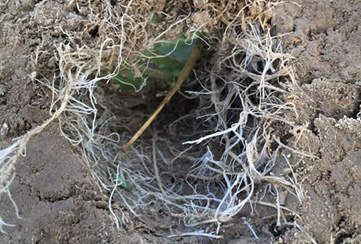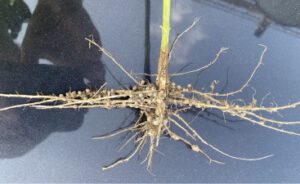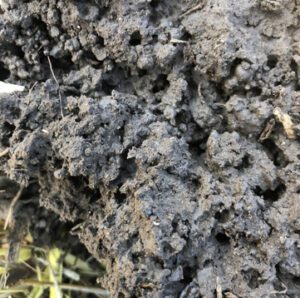
Article Written By: Shannon Cappellazzi PhD, Director of Research at GO Seed
This excellent article is from “The Cover Crop Corner” educational column put out by our friends at GO Seed. For more information or to be added to the distribution list, please email fgonzales@goseed.com.
Restoring the capacity of the soil to function is done by regenerating the soil into a vital living system. Let’s start by viewing the soil as the habitat for billions of organisms. What do all organisms need to have a healthy habitat? They need food, water, air, and shelter. When we take deliberate steps to restore the soil as a habitat it regains its ability to function. When the soil functions properly it is better for all inhabitants on earth and can also yield a significant increase in farm profits.
The number one word I associate with improved soil vitality and function is ROOTS. Soils need plants to capture carbon from the atmosphere and send it through their roots to feed the multitude of organisms that actively create structures, cycle nutrients, and regulate the water cycle. In the pursuit of soil health, perennial, well-managed, grazing systems are best. But when animals are not an option, adding cover crops is the number one management practice I consider critical to incorporate into a row crop system. Below is a taste of how cover crops improve the soil as a living habitat.
Food – Nutrient Cycling
All organisms need to “eat” something, and organic carbon is key to getting soil organisms to cycle nutrients your crops need from the soil. Carbon, the primary component in organic matter, is what feeds the microbial community who provide the services of cycling mineral and organic nutrients, making them available to plants. Most of the carbon added to the soil actually comes during the active growing process, rather than from plant residue. Roughly 40-60% of the carbon that plants capture through photosynthesis is sent through their roots into the soil because it is beneficial to plant growth. Plants feed the microbes, and microbes feed the plants.
A well-known example of this mutually beneficial nutrient trading relationship is between legumes and rhizobia bacteria. Plants send carbon signals and food to rhizobia which create specialized nodules in legume roots where they live and work. These nodules create a special anaerobic environment where they can break down the very strong triple bonds of atmospheric nitrogen (N2), and make it available to plants.

Photo By: Zach Louk
Also, 80-90% of all plant species on earth form symbiotic associations with mycorrhizal fungi, which live in and on plant roots. Again, the plant captures carbon through photosynthesis and sends it to the roots to deliver to the fungi. The fungi then grow and reproduce and since they are inside of the plant roots, this causes a massive increase in the total surface area of a root. This increases the amount of soil surfaces which the root encounters which increases its ability to exchange nutrients and scavenge for water. The fungi also produce many enzymes which break down even more nutrients for the plant to take up.
Still another way that cover crops can impact the balance of food in the ecosystem is by reducing nutrient leaching through the soil profile and runoff over the surface. Available nutrients are taken up by the plants rather than having a negative impact on downstream aquatic species. The captured nutrients can be released in the following season during decomposition of the cover crop while the cash crop is growing. The economy of nature relies on trading of carbon so everyone can get what they need. The more carbon is exchanged through the root bank, the more the natural capital of the soil grows and the more you will be able to save in fertilizer bills.
Shelter – Physical Structure
It might seem odd to consider, but soil organisms build themselves “shelters” and in so doing create pore spaces and aggregates. Microbes exude carbohydrates, proteins, DNA, enzymes, and lipids into their immediate surroundings, that overtime build a biofil enhanced environment where microbes carry out their work. As microbes do this in soil, the organic molecules glue mineral particles together which stabilizes pore spaces for water, gas, and allows organisms to move and aggregates the soil. Plants, worms, and the rest of the organisms living in the soil also contribute to the formation of stable aggregates by tunnelling through, digesting particles, strapping them together, and pushing them around. This diversity of action and production produces a positive feedback cycle allowing the plants and micro-organisms to be better at their jobs and build more intricate underground architecture creating unique niches and shelter for organisms which enhance the soil’s ability to perform the functions that are useful for us.
A direct benefit of these organisms building their shelters is that these communities working together can alleviate compaction. Again, plants provide organic carbon to the soil organisms but also works through the direct action of roots pushing through the soil. Aggressive fibrous rooted crops like sorghum and ryegrass can penetrate tight soils which in turn allows water to penetrate the soil surface. Deep tap rooted crops like radish, sunflower and balansa clover can drive roots down deep, even through a tight clay or plow pan. The roots of the following cash crop can then move through the compaction zone which increases the total soil volume available for the plant to find nutrients and water which has demonstrated increases in yield.
Water – Cycling and Storage
Many soil microbes can go into a dormant state when the soil dries out, but for them to actively cycle nutrients and build structures, they need water. The good news is that when we take care of the food (carbon) and shelter (pores and aggregates), the water that does come will be optimized. Texture has a strong influence on the natural tendency of how soil interacts with water. However, for any given soil, increased carbon increases infiltration rates and storage as well as decreases ponding and nutrients flowing out. It may seem counter intuitive that we can increase water holding and improve water movement at the same time, but we can. These multiple processes are possible when the built habitat has a variety of pore sizes and aggregates with an active microbial community. Large pores are stabilized with roots and hyphae and worm slime and exudates allow water to flow in and out around aggregates and particles rapidly. Stable aggregates create many smaller pores and intricate structures, and the smaller the pore the tighter the water is held. I have measured dryland silty soils, both with and without cover crops, that had 16% and 7% gravimetric moisture respectively. This can be, the difference between high and low yield in this dryland wheat system. That same soil allowed one inch of water to infiltrate in 15 seconds in the area with the cover crop and three minutes without the cover crop.

Photo By: Gary McDonald
Cover crops also help capture water when they are left as residue on the surface. When rain falls, there is a lot of energy in each one of those droplets hitting the surface and that will often dislodge even well aggregated particles. Anytime a living plant or residue can break the fall of a water droplet, there is a decreased risk that the aggregates will break, and the individual particles will form a seal causing reduced infiltration. They also provide an insulation layer that moderates temperature reducing evaporation.
Closing thoughts
At this point, I hope you are thinking more about which cover crops you are going to use rather than if you are going to use cover crops. I think the first questions to ask yourself should be related to your specific goals and challenges. Select cover crop species that have demonstrated the ability to address your production problems or complement your strengths.
Soil is the natural capital of the land. When you invest in soil health by planting a cover crop, not only are you making an impact on all of the downstream ecosystem services that are related to soil functions, but you are also forging a lasting legacy for future generations of agricultural producers and protecting your long-term investment.
This article first appeared in the 8th Edition of Green Cover's Soil Health Resource Guide.
Also check out the 10th edition, our latest Soil Health Resource Guide, over 90 pages packed with scientific articles and fascinating stories from soil health experts, researchers, farmers, innovators, and more! All as our complimentary gift to you, a fellow soil health enthusiast!